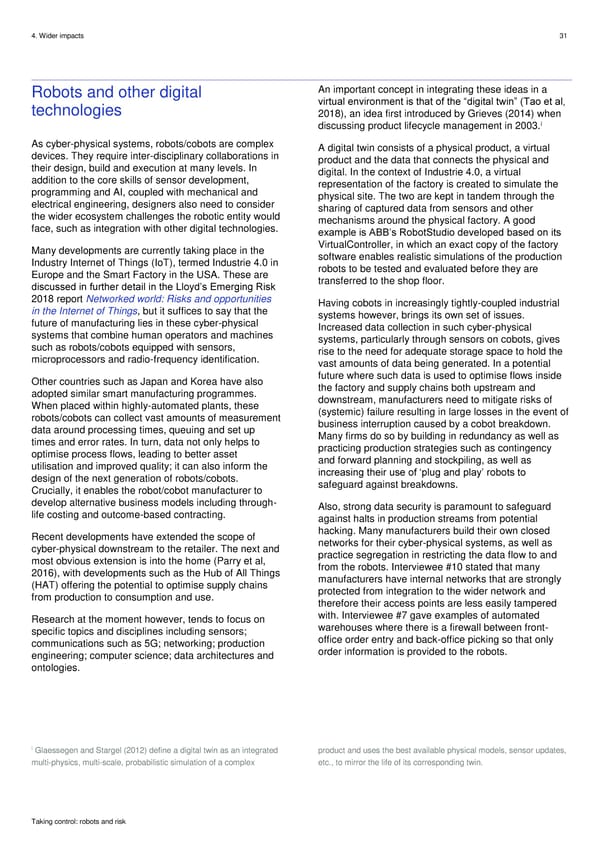4. Wider impacts 31 Robots and other digital An important concept in integrating these ideas in a technologies virtual environment is that of the “digital twin” (Tao et al, 2018), an idea first introduced by Grieves (2014) when discussing product lifecycle management in 2003.i As cyber-physical systems, robots/cobots are complex A digital twin consists of a physical product, a virtual devices. They require inter-disciplinary collaborations in product and the data that connects the physical and their design, build and execution at many levels. In digital. In the context of Industrie 4.0, a virtual addition to the core skills of sensor development, representation of the factory is created to simulate the programming and AI, coupled with mechanical and physical site. The two are kept in tandem through the electrical engineering, designers also need to consider sharing of captured data from sensors and other the wider ecosystem challenges the robotic entity would mechanisms around the physical factory. A good face, such as integration with other digital technologies. example is ABB’s RobotStudio developed based on its Many developments are currently taking place in the VirtualController, in which an exact copy of the factory Industry Internet of Things (IoT), termed Industrie 4.0 in software enables realistic simulations of the production Europe and the Smart Factory in the USA. These are robots to be tested and evaluated before they are transferred to the shop floor. discussed in further detail in the Lloyd’s Emerging Risk 2018 report Networked world: Risks and opportunities Having cobots in increasingly tightly-coupled industrial in the Internet of Things, but it suffices to say that the systems however, brings its own set of issues. future of manufacturing lies in these cyber-physical Increased data collection in such cyber-physical systems that combine human operators and machines systems, particularly through sensors on cobots, gives such as robots/cobots equipped with sensors, rise to the need for adequate storage space to hold the microprocessors and radio-frequency identification. vast amounts of data being generated. In a potential Other countries such as Japan and Korea have also future where such data is used to optimise flows inside adopted similar smart manufacturing programmes. the factory and supply chains both upstream and When placed within highly-automated plants, these downstream, manufacturers need to mitigate risks of robots/cobots can collect vast amounts of measurement (systemic) failure resulting in large losses in the event of data around processing times, queuing and set up business interruption caused by a cobot breakdown. times and error rates. In turn, data not only helps to Many firms do so by building in redundancy as well as optimise process flows, leading to better asset practicing production strategies such as contingency utilisation and improved quality; it can also inform the and forward planning and stockpiling, as well as design of the next generation of robots/cobots. increasing their use of ‘plug and play’ robots to Crucially, it enables the robot/cobot manufacturer to safeguard against breakdowns. develop alternative business models including through- Also, strong data security is paramount to safeguard life costing and outcome-based contracting. against halts in production streams from potential Recent developments have extended the scope of hacking. Many manufacturers build their own closed cyber-physical downstream to the retailer. The next and networks for their cyber-physical systems, as well as most obvious extension is into the home (Parry et al, practice segregation in restricting the data flow to and 2016), with developments such as the Hub of All Things from the robots. Interviewee #10 stated that many (HAT) offering the potential to optimise supply chains manufacturers have internal networks that are strongly from production to consumption and use. protected from integration to the wider network and therefore their access points are less easily tampered Research at the moment however, tends to focus on with. Interviewee #7 gave examples of automated specific topics and disciplines including sensors; warehouses where there is a firewall between front- communications such as 5G; networking; production office order entry and back-office picking so that only engineering; computer science; data architectures and order information is provided to the robots. ontologies. i Glaessegen and Stargel (2012) define a digital twin as an integrated product and uses the best available physical models, sensor updates, multi-physics, multi-scale, probabilistic simulation of a complex etc., to mirror the life of its corresponding twin. Taking control: robots and risk
 Robots & Risk Page 30 Page 32
Robots & Risk Page 30 Page 32